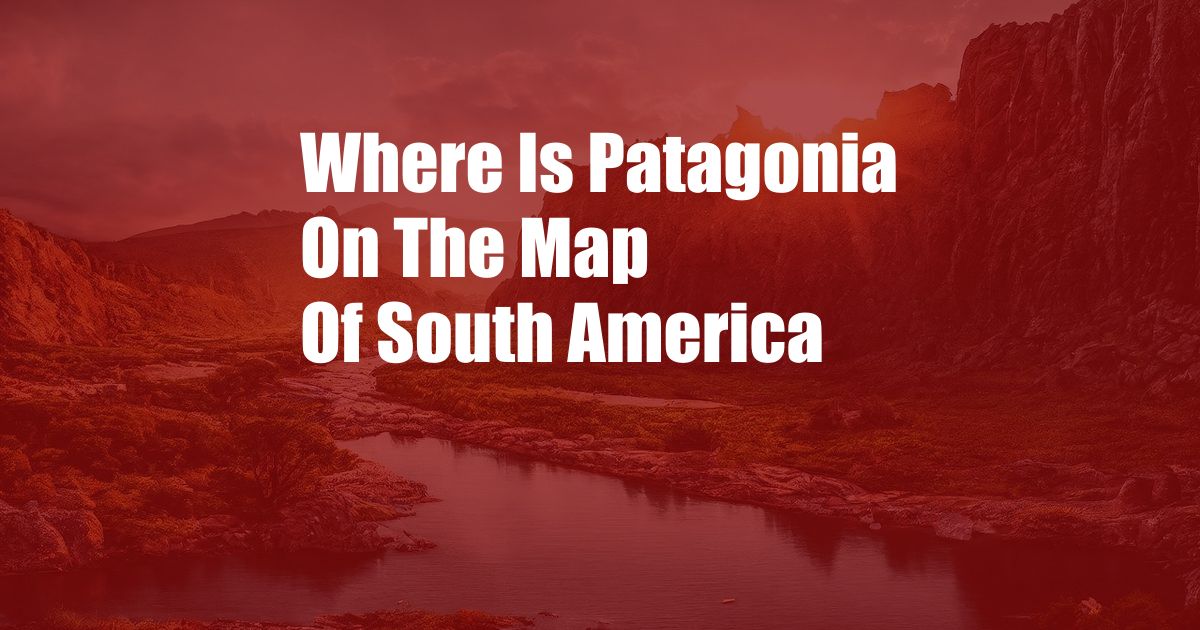
Where is Patagonia on the Map of South America?
Patagonia, a captivating region that has captured the imaginations of explorers and adventurers alike, unfolds as a majestic land in the southernmost reaches of South America. Nestled between the towering Andean peaks and the vast expanse of the Atlantic Ocean, Patagonia’s allure stems from its unspoiled wilderness, dramatic landscapes, and rich cultural heritage.
The Cradle of Patagonia: A Geological Journey
The geological forces that shaped Patagonia’s breathtaking tapestry began millions of years ago. The region emerged as part of the supercontinent Gondwana, which included present-day South America, Africa, Antarctica, Australia, and the Indian subcontinent. As Gondwana fragmented, Patagonia found its place as a part of South America.
A Diverse Tapestry: Patagonia’s Natural Wonders
Patagonia’s diversity manifests in its awe-inspiring array of natural wonders. This boundless realm encompasses towering granite peaks, pristine lakes, sprawling grasslands, and coastal fjords. The rugged Andean peaks, including the legendary Mount Fitz Roy and the formidable Cerro Torre, beckon climbers from around the globe. Vast lakes, such as Lago Argentino and Lago Nahuel Huapi, mirror the grandeur of the mountains while offering ample opportunities for kayaking, fishing, and wildlife viewing.
A Sanctuary for Wildlife
Patagonia serves as a vital sanctuary for a wealth of wildlife. The region is home to an array of species, including the elusive Andean condor, guanacos, pumas, and a diverse array of birdlife. The coastal waters teem with marine life, including whales, dolphins, and sea lions. The Península Valdés, a UNESCO World Heritage Site, provides a safe haven for breeding colonies of Magellanic penguins and elephant seals.
A Melting Pot of Cultures
Patagonia’s rich cultural tapestry is a blend of indigenous Mapuche traditions, European influences, and modern advancements. The indigenous Mapuche people, with their deep connection to the land, have preserved their cultural heritage through their vibrant ceremonies, handicrafts, and language. European settlers, primarily from Spain, brought their architectural styles and farming practices, shaping the region’s towns and countryside.
A Land of Adventure and Exploration
Patagonia continues to captivate adventurers and explorers with its endless opportunities for outdoor recreation. Trekking through the remote backcountry, mountain climbing, kayaking amidst towering peaks, and wildlife safaris are just a few of the experiences that await those who venture into this wilderness paradise. The region’s pristine national parks, such as Torres del Paine National Park and Los Glaciares National Park, offer breathtaking scenery and unparalleled adventure.
Tips and Expert Advice for Exploring Patagonia
-
Plan ahead: Patagonia’s vastness requires careful itinerary planning. Research destinations, book accommodations, and secure necessary permits in advance.
-
Pack for all conditions: Patagonia’s weather can be unpredictable, so pack clothing for all seasons. Waterproof layers, sturdy footwear, and a backpack are essential.
-
Respect the environment: Patagonia’s wilderness is fragile. Practice responsible camping, minimize your impact, and respect wildlife.
-
Hire a local guide: Experienced guides provide valuable insights, safety, and an understanding of the region’s hidden gems.
-
Take your time: Patagonia’s beauty is best savored slowly. Allow ample time to explore and absorb the region’s majesty.
Frequently Asked Questions about Patagonia
Q: What is Patagonia’s climate like?
A: Patagonia’s climate varies significantly due to its geographical diversity. The west coast experiences a maritime climate with cool, wet summers and mild, dry winters. The eastern region has a continental climate with hot, dry summers and cold, snowy winters.
Q: How can I get to Patagonia?
A: The most popular gateway to Patagonia is through the cities of El Calafate and Bariloche in Argentina or Punta Arenas in Chile. Direct flights and bus connections are available from major cities in South America and Europe.
Q: What are the best things to do in Patagonia?
A: Patagonia offers a myriad of activities, including hiking, mountaineering, kayaking, wildlife viewing, and cultural exploration. Visiting national parks, exploring glaciers, and taking scenic drives are highly recommended experiences.
Conclusion
Patagonia stands as a testament to the earth’s boundless beauty. Nestled at the southernmost point of South America, this region offers a symphony of natural wonders, cultural heritage, and adventure. Whether you seek solace in its pristine wilderness or embrace its thrilling challenges, Patagonia beckons you to discover its untamed spirit.
Would you like to add anything about your recent trip to Patagonia?